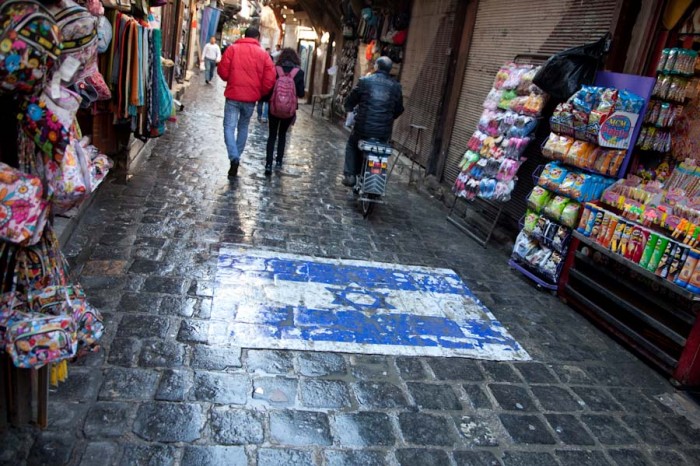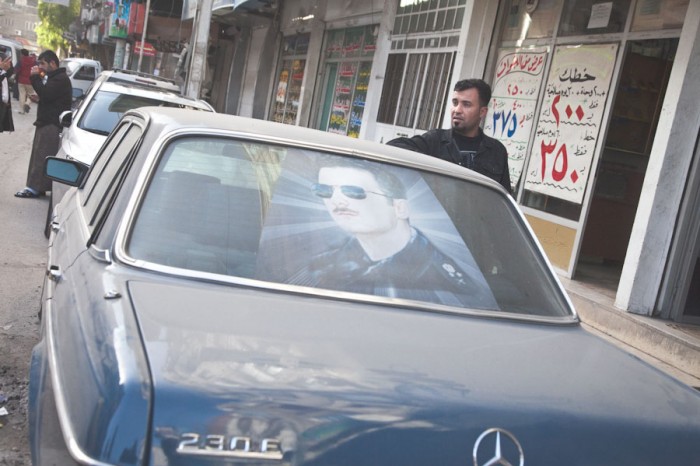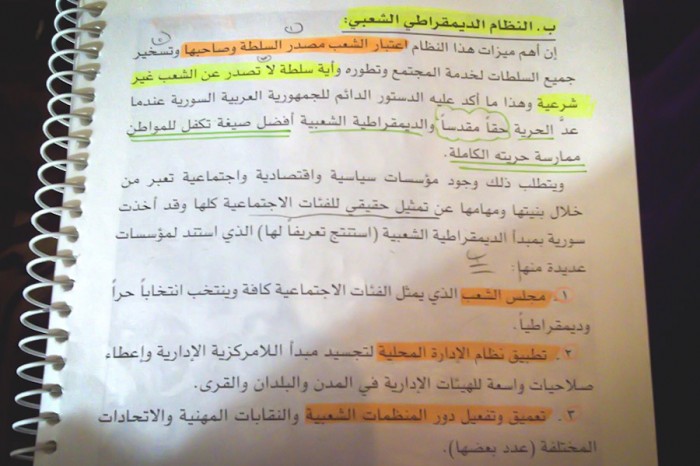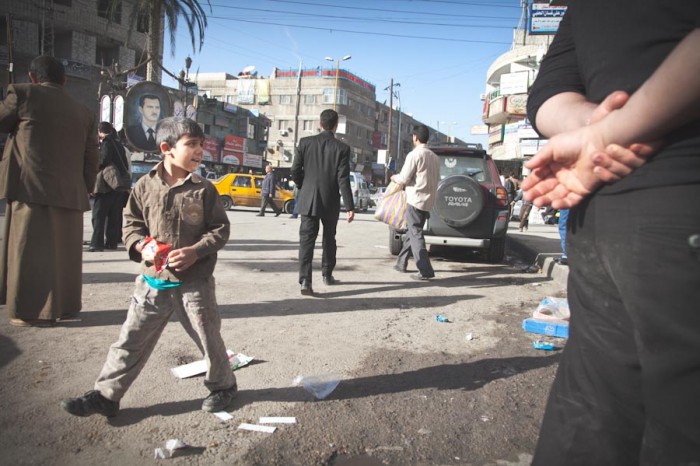“Let’s talk about the holocaust,” my Syrian Civic Education teacher said one morning back in 2010 — to an unusually full and hushed classroom.
“The Holocaust,” he said, “IF it in fact occurred, was greatly exaggerated in numbers.”
Complete silence.
“There is no physical evidence or scientific research that exists today that proves that the claimed six million figure was in fact correct.”
The Syrian Ministry of Education had only that year succeeded in forcing my private, French-government-affiliated school to let their teachers come and deliver the state-mandated lessons in Civic Education, Syrian History, and Syrian Geography.
In the 40 years leading up to the current revolution, the Assad regime had managed to sustain popular support in many ways — just one of them was through the public K-12 education system. This system embedded a blind faith in the regime deep in people’s minds by painting Syria as a strong, valiant defender against a clearly defined enemy.
For a long time, the system worked. And that year, they were coming after our little private school bubble.
My senior class at the time was proud to be the most rebellious at our high school. We adamantly refused to sit in on most of these classes; we would skip constantly or just ask to go to the bathroom and never come back.
But after a few months of constant en-masse skipping, our desperate professors and angry principal explained that if we kept on, the government was threatening to shut down the school.
So we gave in one fateful morning and decided to listen to what our nationalistic professor had to say.
One thing is certain: That morning, the professor indeed succeeded in getting our full attention. Here was a man before us speaking our mother tongue and telling us the complete opposite of what the French-speaking professors who came from abroad had been teaching us for years. This was my first encounter with what the other 99% of Syrian high school students might have learned at my age.

We asked a few questions, but we did so warily; the last thing you wanted to do in Syria was contradict the government. Imprisonments and disappearances were not an uncommon consequence of doing so, and if one forgot this, all it took was a glimpse of a photo of Bashar (or worse, his father Hafez) on the corner of a street or on the wall of a classroom or even on someone’s car to remind you.
Add to this the constant “Shh! The walls have ears! Do you want to sleep at your aunt’s house tonight?” (aunt’s house = prison) comments that you got from everyone anytime you talked about politics, even if you were in the safety of your own home. This teacher was very likely a member of mukhabarat, the far-from-secret intelligence agency that kept an eye out for possible opponents of the system. So we avoided arguing with him.
I’ve since had the chance to go back to my high school Civic Education textbooks and check for what the teacher had said. I found almost nothing on the subject at all — because, in fact high school history and Civic Education textbooks in Syria barely even cover World War II.
I did find the books filled with references to the Israel-Palestine conflict. It took me almost a year after moving away from Syria for college to get used to saying the word “Israel” without lowering my voice or looking over my shoulder. Growing up in Syria had instilled in me an innate conviction that Israel was the national enemy, and that any mention of the enemy in a non-negative context was dangerous.
Looking through the Syrian textbooks that I was lucky enough to have not been forced to memorize myself, I began to understand one of the principal tools the Syrian government used to imbed an ideology into its people.
At the beginning of every book is the picture of the president, the name of the deceased Hafez Al Assad is always preceded by “the immortal leader.” And Israel is almost always referred to as the “Zionist occupier,” or the “Zionist enemy,” but never as a country or a people. On maps, the Golan and Alexandretta are always drawn within the Syrian borders, and are often referred to by people as “occupied territories” by Israel and Turkey. The Palestinians are “our brothers” and Syria remains one of the only countries that are fighting to liberate it — even though official clashes hadn’t broken out between Syria and Israel since the 1973 war (not counting those that have occurred since the beginning of the revolution).

To be fair, a lot of what was taught in history classes was also true. The Levant was once a cradle of civilization, breeding worldly philosophers and mathematicians. This proud history of my country and the region is one that is unfortunately rarely taught in the West. But in between the lines of this rich history textbooks subtly manipulated students into almost adulating the government, and fearing the enemy.
Here is an example: Chapter 17 of the 12th grade Baccalaureate program Civic Education textbook talks about terrorism. One of the paragraphs reads as follows:
“Who exercises terrorism?
a. Individuals (such as the Israeli, Goldstein who killed the people praying in the Aqsa Mosque)
b. Groups (such as the Hagana mobs who committed the massacres of Deir Yassin and Kafr Kasem)
c. A state (such as the Zionist entity that committed massacres against the Arab people in Sabra and Shatilla)”
Syrian textbooks taught students selected information to shape their opinions. The creation of an omnipresent, infinitely evil enemy further legitimized the rule of the Assad regime. It created the ever-necessary sense of community: Keep people united against a common enemy, and they won’t become divided against you.
There was a nationwide conviction that Syria was a great country, that it had fiercely defeated its enemies (after all, we “won” the 1973 war against Israel) and still stands up to the “imperialistic” West. There was also a faith that the Assads were quasi-royalty who had saved us from a constant instability in the post-French mandate decades, that they continue to protect us from the danger that is our Southern neighbor, and that without them, we would never have the glorious democratic nation that we had today.

My class was rebellious, but I do believe this: The real reason we skipped all those classes was not because we wanted to be troublemakers, but because we knew, though we dared not say it, that these classes were the symbols of regime propaganda infiltrating our little bubble of privilege.
Since graduation, my classmates and I have broken off and been divided by geography, but also by our ideologies: many agreed with the revolution, others remained loyal to the regime. Either way, however, we had all realized that the version of “democracy” we learned about from our French professors and the version of democracy and freedom that we experienced in our own country were far from being alike.
This is a realization that I believe the people of Syria came to overall — that the glorious shining image they had learned about in school was not the reality they were living in.
Though some information is taught selectively, democracy is defined as follows in a twelfth grade Civic Education textbook:
“The people are regarded as the source of power and its owners.
Any authority that does not stem from the people is considered illegitimate.
The Constitution affirms that freedom is a sacred right and that popular democracy is the best form [of government] that guarantees the civilian’s ability to exercise his freedom.”
This definition, which the Ministry of Education so willingly printed in its textbooks, and which is portrayed in the Syrian Constitution, was later ironically turned against the regime in chants and on billboards.
The revolution has shattered this lens through which the regime had conditioned its people to see it and the world, and a return to the unconditional support Assad had once succeeded in instilling is far from likely.
I guess Civic Education classes actually did prove useful to Syrians after all.



Nice Article ;)
Cheers from Marseille where my friends successfully got my cards from Seattle
Adrien
This comment has been removed in accordance with our comment policy.